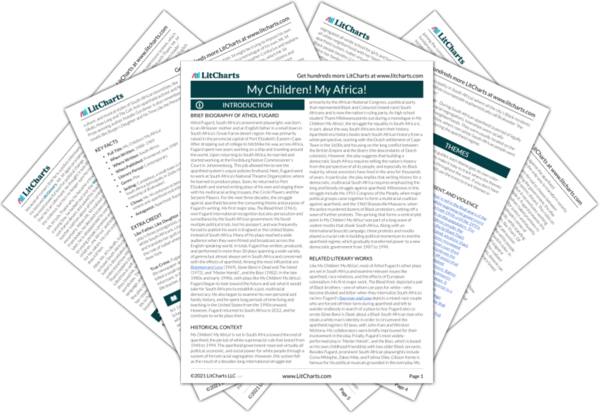Mr. M’s school bell represents the consistency, formality, and safety of the education system. This contrasts with the brutal, chaotic realities of the apartheid system and the anti-apartheid revolts that Black students face outside school. The bell first appears in the play’s opening scene, when Mr. M rings it to calm Thami and Isabel down during an unruly, passionate debate. Similarly, when Thami remembers his childhood, he starts by remembering the school bell, which he associates with the sense of confidence, safety, and hope that he has abandoned since getting involved in his community’s anti-apartheid protest movement. In both these cases, the bell symbolizes how school can impose a false sense of order and continuity on life, which is far messier and more complicated than it looks from inside a classroom. Thus, while the play portrays school as a safe place for children to explore ideas and grow, the bell also represents the idea that school can give people a false sense of routine and comfort in an otherwise difficult or intolerable situation.
At the end of the play, during the revolt in Brakwater, Mr. M still rings his school bell every morning, even though none of his students show up because they’re involved in the protests. Although Mr. M insists that he wants to bring the world “to its senses,” he clearly fails to understand his students’ new reality. By ringing the bell, he shows that he is stuck in his old routine and unable to accept South Africa’s new political circumstances. Indeed, in his final moments of life, Mr. M rings the school bell as he runs out into the angry mob that ends up killing him. Through this image, the play suggests that Mr. M dies in part because he failed to adapt his own values to South Africa’s fraught political climate at this time.
The School Bell Quotes in My Children! My Africa!
Mr. M alone in Number One Classroom. He is ringing his school bell wildly.
MR. M: Come to school! Come to school. Before they kill you all, come to school!
Silence. Mr. M looks around the empty classroom. He goes to his table, and after composing himself, opens the class register and reads out the names as he does every morning at the start of a new school day.
Johnny Awu, living or dead? Christopher Bandla, living or dead? Zandile Cwati, living or dead? Semphiwe Dambuza…Ronald Gxasheka…Noloyiso Mfundweni…Steven Gaika…Zachariah Jabavu…Thami…Thami Mbikwana…
(Pause) Living or dead?










